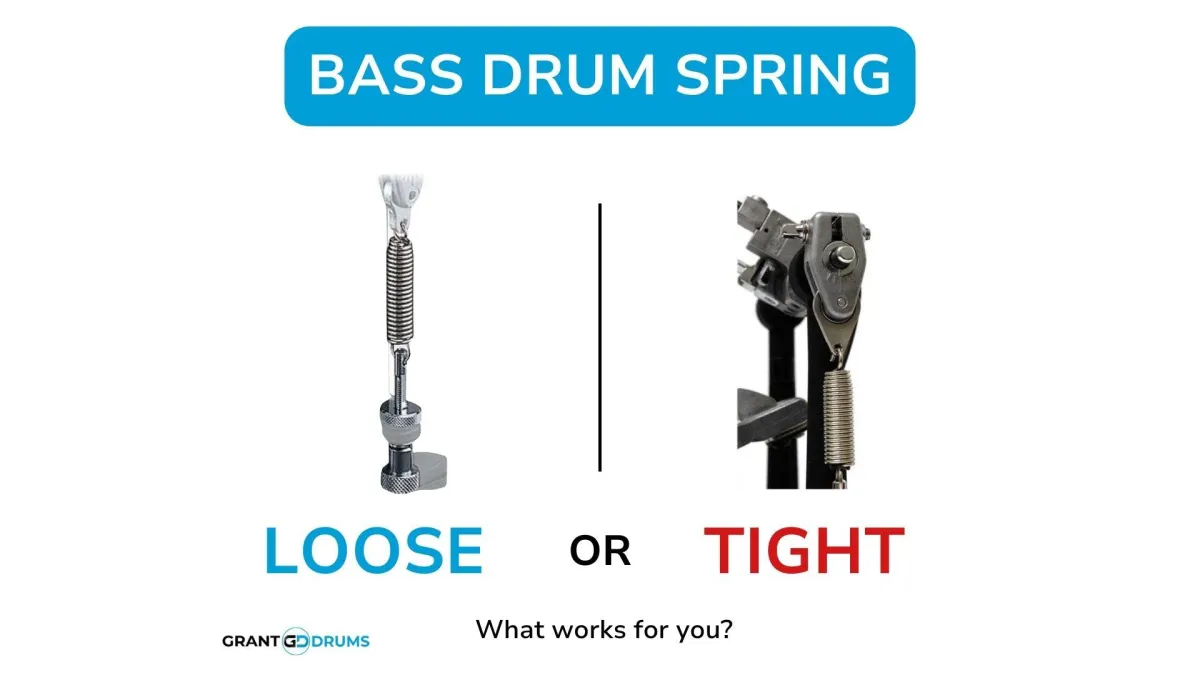ACADEMY MEMBERS
LEARNING TIME
with


Finding Your Groove: Loose vs. Tight Bass Drum Spring Tension
Drummers, we've all been there: fiddling with the spring tension on your bass drum pedal, searching for that sweet spot. Today, we'll explore the world of loose vs. tight spring tension, helping you dial in the perfect feel for your drumming style.
Loose Spring Tension: Freedom and Finesse
Loosening the spring offers a distinct playing experience:
Increased Control: A looser spring allows for more nuanced strokes, making ghost notes and quieter passages easier to execute.
Dynamic Flexibility: You have more control over the rebound of the beater, enabling a wider dynamic range from delicate taps to powerful kicks.
Footwork Freedom: A loose spring can feel more natural and less fatiguing, especially for intricate footwork.
However, loose tension comes with some drawbacks:
Speed Challenges: Achieving lightning-fast double bass drumming might be harder with a loose spring.
Reduced Power: The spring's assistance in pulling the beater back can be diminished, potentially limiting the attainable power in your kicks.
Less Rebound: A loose spring might require more active leg work to maintain a consistent playing feel.
Tight Spring Tension: Power and Precision
Cranking up the spring tension delivers a different set of advantages:
Fast and Furious: Increased spring tension aids in quicker leg strokes, making high tempos and double bass techniques more achievable.
Explosive Power: The spring provides more "kick" to your strokes, ideal for heavy music styles that require powerful bass lines.
Consistent Rebound: A tight spring helps maintain a predictable beater bounce, simplifying complex footwork patterns.
But tight tension isn't without its downsides:
Fatigue Factor: Fighting against a strong spring can lead to muscle fatigue over extended playing sessions.
Dynamic Limitations: A tight spring might make it harder to achieve subtle dynamics, potentially sacrificing some nuance in your playing.
Less Footwork Control: The spring's influence can make delicate footwork and ghost notes more challenging.
Finding Your Bass Drum Spring Sweet Spot
The ideal spring tension is a personal preference that depends on your playing style and desired feel. Here are some tips for finding your sweet spot:
Consider Your Genre: Heavy rock drummers might favor a tighter tension for power, while jazz drummers might prefer a looser setting for finesse.
Experiment and Feel: Start with a medium tension and gradually adjust it, focusing on what feels natural and allows you to execute your desired dynamics and techniques.
Listen Closely: Pay attention to how the spring tension affects the overall sound of your bass drum. Aim for a balance of power, clarity, and dynamic control.
Remember: There's no right or wrong answer. The best spring tension is the one that allows you to play comfortably, achieve your desired sound, and express yourself musically. Don't be afraid to experiment and find what works best for you!
Happy drumming, and may your bass drum spring tension propel you to rhythmic greatness!
Sick of losing focus and trying every drum exercise you can find on YouTube?
It's time for the...


FREE DRUM CHART
CHOP CHOP
Drum Chart
22 Time Signature Changes in 59 Seconds!
Enter your details and get the chart to your inbox in minutes!
You will receive your Free PDF Chart to your inbox. Please check your spam filters if you can't see it.
Your email will come from help@mail.grantdrums.com



